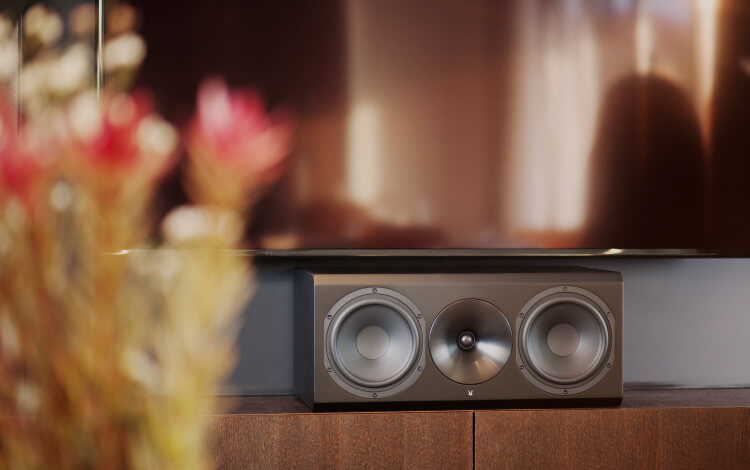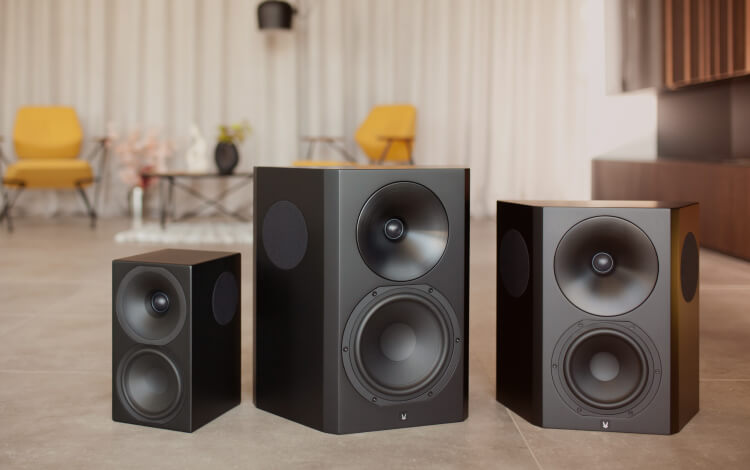REFERENCE CLASS – MAGNIFICENT DISPLAY
Norwegian Arendal Sound has over the last years delivered proper enthusiast speakers, for home cinema as well as for music, and I can say without exaggeration that I was really thrilled when I got the new subwoofer delivered.
The original 1723 series has now been upgraded with brand new subwoofers, and when I was about to order I thought “ehh, let me have the big one”, so rather the 1723 Subwoofer 2V. The number 2 stands for two drivers, and V stands for vented. 2V has a smaller brother, 1V, as well as sealed options; 1S and 2S.
A real ace
1723 2V is appearance wise the same as last generation 1723 Subwoofer 3, but the vent has been reworked for even deeper bass. In the manual it says that 1723 Subwoofer 2V could be the perfect replacement for your coffee-table, and even if it is written with a certain humour, Arendal has a point with their table-thoughts. It is a combination of an extremely stable (and heavy) cabinet and drivers on each side that gives a bass that barely vibrates in the cabinet at all, so even if you place something on top of the 2V it doesn’t create any problems!
About 70 cm tall, half a meter wide and over 60 cm deep makes 1723 2V a mighty presence even before it is hooked up. I have used a normal sack trolley to move 2V in the room, and that actually works quite well. With a piece of cloth or similar for protection, even the paint job handles it well, even after repetitive lifts.
“It is difficult to choose what is really the best about Arendal 1723 2V,
because this is actually a subwoofer that is fantastically good on everything!”
When I had to fine-tune the placement I had to use a different approach though, basically we used a plywood board with 50mm rubber wheels. Such a solution can make it much easier to make incremental movements.
A friend points out that the subwoofer then is lifted about 80 mm from the floor, which in and of itself is true, but my experience tells me that this aspect does not matter much for measurements nor listening impact.
The cabinet is built in HDF, the super heavy brother of MDF (HDF weighs about 1/3rd more) and the solid (to say it carefully) cabinet walls of 25mm with twice the thickness for its baffles and an internal brace all the way through.
New driver
The first thing that hits you when checking the specs is that the 13.8” large driver has gotten a 50 % increase in its length of stroke, but that is far from the only point that is new about the driver. On the contrary, Arendal has tinkered with almost everything to be able to squeeze out even more from the new driver. The magnet field has been made more efficient through thicker shorting rings, which improve control over the impedance, which gives lower distortion and better response.
The suspension has also been improved in order to handle the longer throw, while the super stiff cone in fibre-armed cellulose is acoustically dead and self damped. Airflow under the dust cap has also been improved with further ventilation holes in the cone body and under the spider, and all together these changes give advantages of lowered distortion and increased power handling.
The driver is by the way protected, just as in the old 1723, by metal rings covered with cloth which fastens to the baffles with magnets. Extremely clean, even though I prefer using them without grilles.
New amplifier and processor
Compared to the “old” 1723, the new series has more power: 800 watt for the models with single drivers and 1200 watt for the models with dual drivers. There is even a plethora of adjustability, and soon also an APP to control all parameters of the bass.
Magnificent adjustability
I more or less remember the controls from last time I reviewed Arendal-subwoofers (1961, reviewed in HB 10/2019). There is a wheel together with two buttons, respectively “menu/back” and “enter” and a small, high resolution color display that very clearly shows what you are doing. Some time beginning of next year there will also be an APP to control the subwoofers in the new 1723 series.
The first thing I want to write about is that all the changes have to be confirmed with “enter”, so that you change the value and then press “menu/back” saves the setting. The second thing I would like to mention is the scroll wheel has a super smooth functionality, if you turn the wheel slowly, the parameters are adjusted slowly, yet if you turn the wheel faster it jumps in much larger chunks, something that is very clearly noticed when you adjust the Q-value in the Parametric EQ bands!
“the subwoofer completes the stereo setup in an absolutely magnificent manner.”
The third thing I would like to shine a light on, is that one doesn’t have to adjust a whole lot of settings if one doesn’t want to. If you just set the input level on “Ref” and connect the subwoofer to your AVR, it will sound great. But if you are the kind of person that wants to tweak to get the maximum out of your setup, then Arendal gives you ample adjustability!
You can make a completely different set of adjustments for each input type, so the first thing you choose is XLR or RCA depending on which you would like to adjust. It is an incredibly smooth function as you can use the different inputs to completely different tasks. For example you can connect the subwoofer to two completely separate systems. When you have chosen the input, you just start adjusting!
Levels
The first setting to adjust is the levels, where you have the option of setting it to reference level, which is the normally recommended setting for home cinema. You can also set the input gain (-12/-6/0/+6dB for 1/2/4/8 V source signal) and if you turn off “Ref” level you can adjust master volume between -20 and +20dB.
Crossover
The next setting has to do with crossover settings, and here is quite a bit more than just crossover frequency and slope. We will take it from the beginning.
There are three EQ settings for 2V in sealed mode and vented mode respectively (the three that are called sealed can also be used with the cabinet vented, but I have not measured that), where EQ1 is the reference position, with EQ2 and EQ3 rolling off a little earlier which is shown from the measurements.
There is an easy LPF on/off adjustment, and thereafter crossover settings (30-160 Hz) as well as slope (6/12/18/24 dB/Octave). Further there is a subsonic filter that can be turned off/on, where you can choose frequencies between 12 and 31Hz, as well as a slope of 6 or 12 dB/Octave.
Lastly you can adjust the phase between 0 and 180 degrees in 10-degree increments, but you can even turn the entire phase around so in practice you can turn it around a full 360 degrees.
Parametric EQ
I am extremely fond of parametric EQ, even though it’s a type of EQ that can partly seem incomprehensible and there are even big chances of making it worse than before. Totally we have 7 bands to work with, and you can adjust frequency (12-200 Hz), levels (-10 to -3dB) as well as Q-value (0.3-10).
You can also turn off/on every band individually so it is very easy to test two alternative settings between toggling them off and on respectively.
Input/Turn-on
Under this meny you can choose which inputs that are going to turn the amplifier on, and how it should happen. You can choose one or both RCA or XLR to turn on the amplifier when there is a signal on the input, which is four different settings. After that you can choose which input(s) that should turn on when you apply trigger signal (3-12v), here also one or two RCA or XLR.
“one of the best subwoofers I have ever heard, regardless of price”
After this you can choose Dual Source, and one can just feel how much Arendal cares about their customers. Here you can configure one or two RCA or XLR to turn on automatically with a signal, and that the input that has not been chosen already will be turned on/off with the trigger input. Add this together with the option of having completely separate settings for XLR and RCA respectively, and you have a subwoofer that can serve two completely separate sound systems!
Setup
In the setup menu you can choose between two memory banks, separate as such for RCA and XLR. You can also choose whether you have 1,2 or 4 subwoofers (Ref. level has to be turned on for this, and this feature ensures that reference level is being upheld in the room) and how long the subwoofer should wait to be turned off after it receives a signal. You can adjust 5-60 minutes and for me that sometimes watch movies at very low volumes, I set it to 60 minutes to ensure the subwoofer never turns off during a movie.
You can also set auto turn-on sensitivity in three steps, and how bright the display should be (in 10 steps). The display can even be rotated 180 degrees, which isn’t a bad idea, as it makes it much easier to make adjustments while laying over the subwoofer, while its rear is turned against the wall.
Reset All
Just what it sounds like. A function that resets all previous settings to factory settings.
Easily adjusted
So I used a board with wheels to move the subwoofer around my home cinema room, and I parked it in the end between my front speakers. This subwoofer is probably the least placement sensitive subwoofer I have ever had the chance of meeting, and if I needed to take any considerations on placement I would have stuffed it to the side.
When the placement was made, I used the PEQ to dampen my room nodes and as multiple bands can be stacked (used on the same frequency) you could reduce the level of more than 10dB if you want. I set it up so that the RCA inputs used the internal crossover, while the XLR inputs had no filter, so I could use the subwoofer both in my stereo setup and my home cinema setup.
Reference class
It is difficult to choose what is really the best about Arendal 1723 2V, because this is actually a subwoofer that is fantastically good on everything! I do have a conversation with Arendals owner Jan Ove Lassesen fresh in memory, and he told me that they always developed the subwoofers with musical capabilities in their mind, as well as that subwoofers that are really good for music also will work really well for home cinema sound.
I start off with a Hegel H120, a pair of Focal Aria 906 and then the 1723 2V, which by first glance may look like a very weirdly matched stereo system, especially as I run the subwoofer ported on EQ1. But as soon as I was able to adjust the levels correctly, through playing pretty loud, the subwoofer completes the stereo setup in an absolutely magnificent manner. Both the amplifier and speakers sound considerably better than they ever have done previously. So then I have subsonic bass for the stereo system, so it’s not much of a surprise that I all of a sudden got a stable low frequency foundation to the music.
Over to home cinema. I have used 2V together with different things from the office, everything from Yamaha’s new RX-V4A to the Lyngdorf/NAD combo from last number, and together with larger speakers (Magnat Cinema Ultra and SVS Ultra) as well as small speakers from Canton and B&W.
In home cinema mode, the 2V gets to work a lot harder, and now you really feel what kind of absolute beast is sitting in the home cinema. The subwoofer grips a hold of the room, shakes everything that isn’t screwed down and offers a rarely felt physical ride. At the same time it manages to support a system consisting of satellites without it being overpowering, and when we run it completely without any other speakers you can hear how little harmonics are actually coming from the subwoofer. We can cross it off higher up in frequency than normal without being able to localise the subwoofer in a sure manner, which is a very good characteristic.
I have even used the 2V together with a pair of Canton AM5 speakers and an active crossover, and at the right levels the gigantic subwoofer can even support these tiny, active speakers in an incredibly nice way.
Conclusion
Dynamics, timing. Finesse, depth and hard hitting bass is in absolute top class, and add to that an almost unlikely ability to sound great even at really low volume, and you have one of the best subwoofers I have ever heard, regardless of price. That idea about using a 2V as a coffee table, may not be such a bad idea yet?
By Magnus Fredholm.











